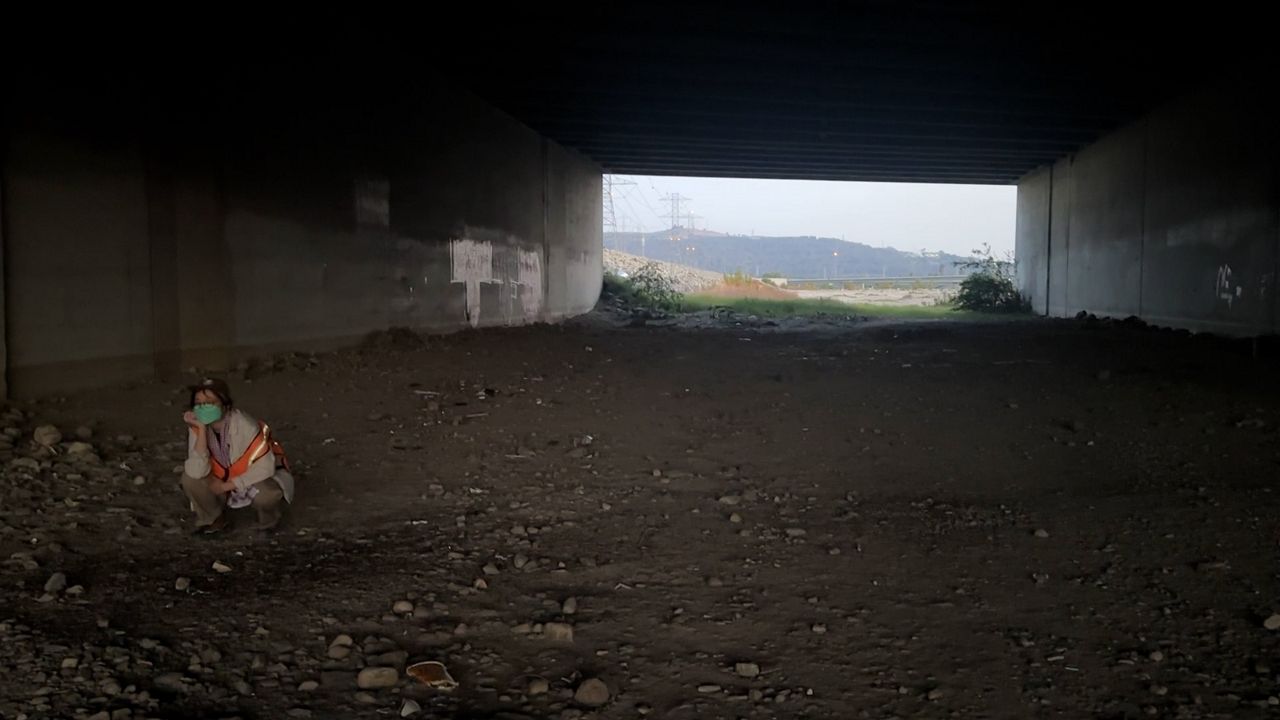EL MONTE, Calif. — There’s a lot of chatter under the 10 Freeway in El Monte, home of hundreds, maybe thousands of bats. To get a better idea of just how many there are and what their lifestyle is like, volunteers spent two nights this month standing still, armed with counter clickers, boom mics and special apps.
“It’s Bat o'clock,” researcher Rachel Blakey said as the sun set and noise rose, the telltale sign that the bats roosting in small cervices of the structure were beginning to rouse. At times, their high pitched chirping was louder than the traffic crossing overhead.
It’s music to Blakey’s ears. She has been smitten with the winged creatures since she first encountered them while studying mines in Australia.
“The more I learned about them, the more I discovered that they're better than all of us,” she gushed. “They can do everything I can do and more, but like, you know, using sound and at night and in 3D.”
She even describes their guano in the most glowing of terms.
“Magical fairy dust,” she commented as she rubbed a small pellet into a fine powder between her fingers, explaining how it gets it sparkle from insect exoskeletons.
Blakey is an assistant professor at Cal Poly Pomona and part of an ongoing study on LA’s urban bat population — led by Miguel Ordeñana, senior manager of community science at the Natural History Museum of Los Angeles County. Their data actually feeds into a global effort to understand bat populations at a grand scale.
“Bats are in decline worldwide for various reasons,” Blakey explained. “There's habitat loss. There’s disease like white nose syndrome — the disease that's wiped out huge amounts of the East Coast populations that's arriving in the West. There's climate change and urbanization, a number of other things.”
To help them better understand our nighttime neighbors, researchers organize two Bat Roost Counts a year — with volunteer community scientists patiently positioned at a number of locations across the county. For Robby Gardner, this was round two. He participated in the count two years ago and found it eye opening.
“I’ve been driving over these freeways my whole life,” he said, “and I’ve never until recently thought about wildlife that could be living on them and, like, using them as their homes.”
Amy Jaecker-Jones, with the Community Science Program of the Natural History Museum, said they couldn’t possibly do this work without the volunteers. Hanging out under a bridge with a bunch of bats is not something everyone will flock to sign up for, in part, she said, because bats are one of the misunderstood species out there.

“Part of it comes from the fear of a vampire bat mythology,” she said. “Some of that also comes from a very real threat of rabies.”
But she said bats aren’t even the worst offenders when it comes to rabies, and overall, they are hugely helpful to humans — especially here in SoCal.
“We are an agricultural region,” Jaecker-Jones explained, “and bats can eat millions of insects in a night…collectively, saving growers billions of dollars annually in not having to spray pesticides. Also fewer pesticides means better health for all of us.”
They also take care of the nuisance insect like mosquitoes, she continued, “and who doesn’t want a mosquito eater in their backyard?”
Although there was some flying about, on the second night of the count, the bats remained pretty tucked away, mainly because it was chilly.
“We think that they're snuggled up warm inside the roost,” Jaecker-Jones told volunteers who had observed bats in the single digits.
Cool nights aside, climate change is already altering the migration patterns and ranges of certain bat species and our urban bats have even more stressors to deal with — light pollution, fires, habit fragmentation. Studies like this will not only increase our understanding of the health and behavior of our local bats, but Blakey says will also allow volunteers to connect in new ways to the wild wonders around them.
“A lot of us in this really big city, we love nature and we love biodiversity,” she said, “but we're not always aware of the biodiversity that's hidden within the human structures and the way that these animals have adapted to our urban structures, our urban environment is just inspiring.”
The next Bat Roost Count will take place on the weekend of Aug. 10 and 11. Sign up information for volunteers will be posted on the museum’s @natureinla social media accounts.












